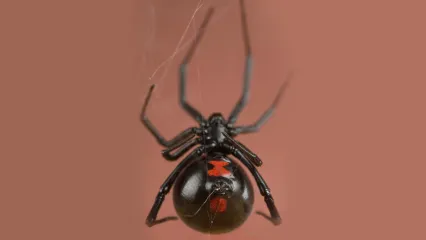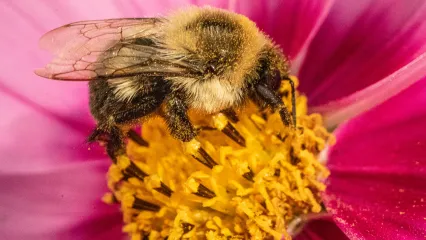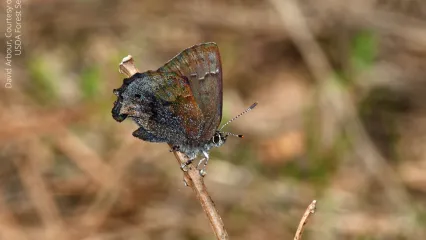
Description
Like wolves and snakes, the black widow spider is the victim of bad publicity. While they are one of the two potentially dangerous spiders found in Oklahoma, their bad public image is somewhat undeserved. The truth is that the black widow has not caused any deaths in the United States for several decades. Also, they are a voracious consumer of insects, particularly flies, crickets, and even cockroaches.
Black widow is actually the common name given to several long-legged, smooth-bodied spiders found in the tropics, southern United States and southern Canada. The female of the species found in Oklahoma, Latrodectus mactans, can be identified by its jet black body with an hourglass-shaped red mark on the underside of the abdomen. When mature, she measures about one and a half inches with her legs extended. Males, which are rarely seen, are only about half as large and usually have four pairs of red dots along the side of the abdomen.
Black widows are the only spiders in the United States with a neurotoxic poison, which means it affects nerves or nervous tissue. The initial bite may feel like a pinprick, and is followed by pain in the vicinity of the bite, muscle aches, severe abdominal pain, vomiting, muscular cramping, sweating, fever, and headache. There is usually no swelling of the bite area, but a small lesion may form. Black widow bites are rarely life-threatening but can be dangerous for small children or people with chronic health problems. They also can be dangerous for pets and are sometimes fatal to small dogs or cats.
Habitat
Black widow spiders are commonly found around homes, garages, barns, and other man-made structures. They build tough, irregularly shaped webs with strands running in many directions. The “messy” looking webs are often found in or behind objects in secluded and protected locations. During the summer they are known to set up house near porch lights in order to make an easy meal of the insects that gather there. They hide during the day and often hang upside down in their webs at night.
Life Cycle
Newly hatched black widows are white with black spots on their abdomens and a cream-colored hourglass. Later, they become cream and brown-striped, before entering their mature color phase. The black widow requires about four months from egg to maturity with the females going through six to nine molts. Over their one- to two-year life span the females produce several egg sacs, each containing several hundred eggs. Female black widows guard the sac, which resembles a silken cocoon, until the eggs hatch. During this time she is most likely to bite. Eggs are most frequently encountered between May to October.
How To Observe
Contact with black widows can be avoided or minimized by observing these practices:
- Be cautious when picking up or moving objects, particularly in outbuildings such as shed or garages, or in shady undisturbed areas such as under parked cars or in flower pots.
- Although they are not commonly found indoors it is always a good idea to shake out and check clothing before putting it on (for brown recluse spiders and scorpions as well).
- Manage household, yard and garden insects (roaches, crickets etc.). Lack of food will discourage spiders and force them to move elsewhere.
- Keep outdoor lighting off as much as possible to prevent luring the insects upon which these spiders feed.
- Remove collections of paper, boxes, rubbish piles in the house, attic, storage areas, etc.
As a part of the web of life, black widow spiders are as important as any other species including deer and quail. Where humankind is concerned it is pointless to try to label them as good or bad - they are simply part of the natural world. Whether they are a nuisance or beneficial involves individual perceptions and reactions.


